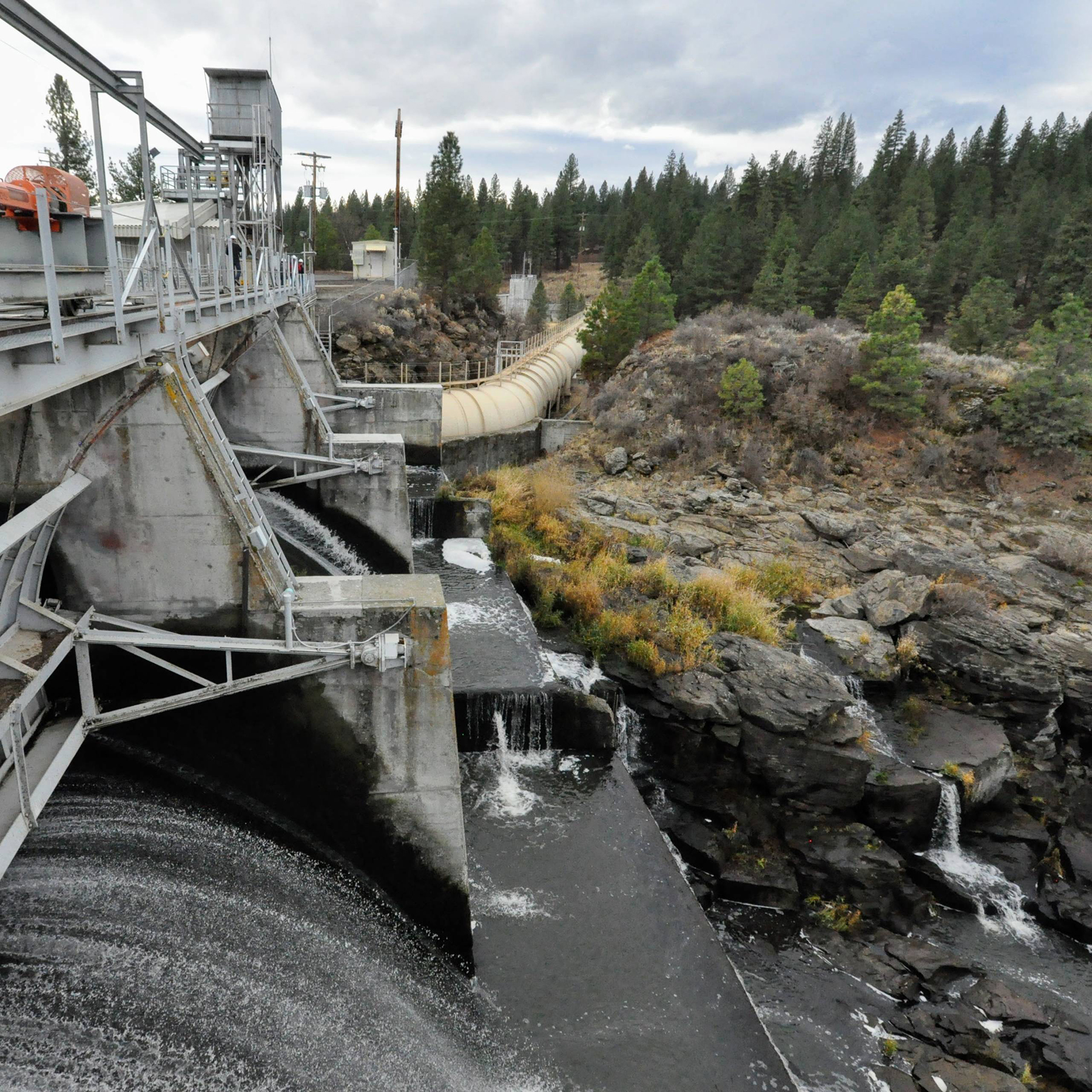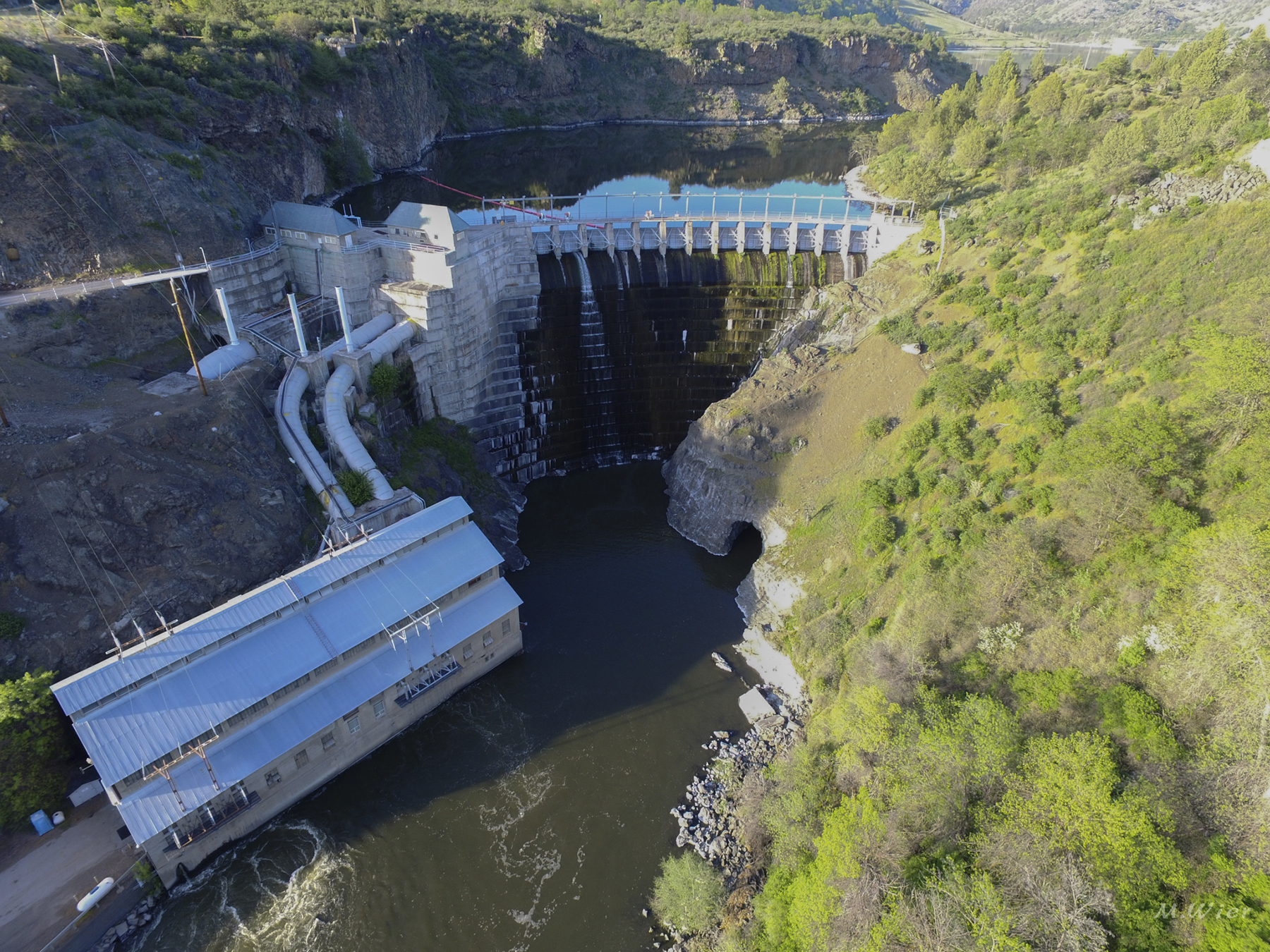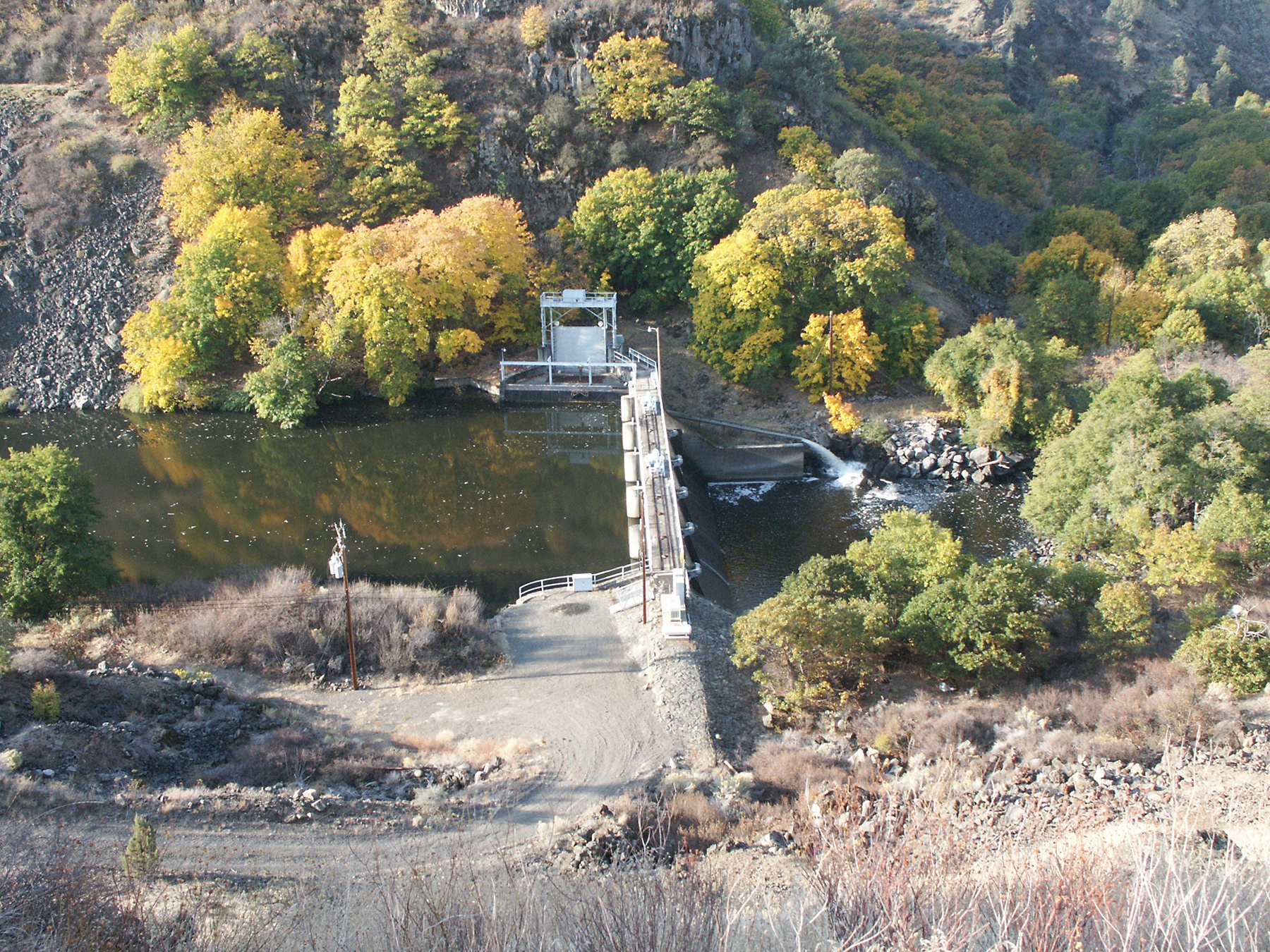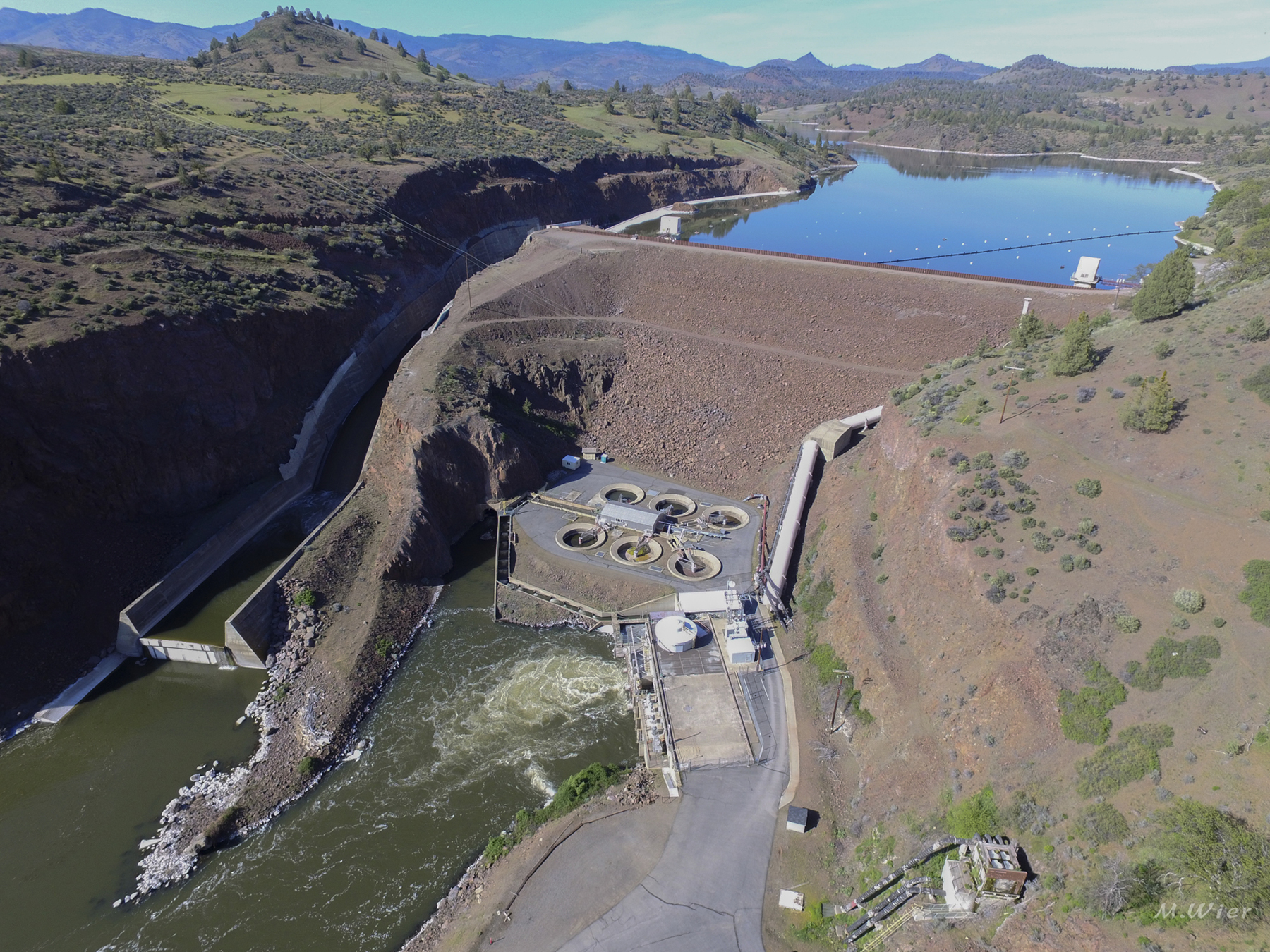By Jay Landers
Initial construction recently began on the long-awaited effort to remove four hydroelectric dams from the Klamath River in southern Oregon and Northern California. Draining a watershed of nearly 16,000 sq mi, the Klamath is California’s second-largest river in terms of average discharge and provides critical habitat for anadromous fish species, which migrate from freshwater rivers to the ocean and back.
Involving the simultaneous removal of the four dams and restoration of more than 2,000 acres of land, the estimated $450 million project is one of the most significant dam removal efforts in U.S. history, according to the Klamath River Renewal Corp., an independent nonprofit organization created in 2016 to oversee the removal process.
The culmination of a regulatory and legal process that has extended nearly two decades, the project aims to improve environmental conditions along the Klamath River and enable key fish species to regain access to hundreds of stream miles, some of which have been closed off for more than a century.
The dams and their effects
The four hydroelectric dams are known collectively as the Lower Klamath Project. These dams were owned, until recently, by PacifiCorp, a utility company that is a subsidiary of Berkshire Hathaway Energy.

In November 2022, the U.S. Federal Energy Regulatory Commission approved the transfer of the license for the Lower Klamath Project from PacifiCorp to the states of California and Oregon and the KRRC. The license transfer was the final hurdle needed before the removal project could begin.
The four dams in question have a combined installed capacity of 163 MW and are approximately 190 to 225 river mi upstream of where the Klamath River meets the Pacific Ocean. Each varies significantly in terms of size, age, and type:
- Located farthest upstream, the 68 ft tall, 693 ft long J.C. Boyle Dam is a combination embankment and concrete structure completed in Oregon in 1958. It has the capacity to impound 3,495 acre ft of water.
- The next-farthest upstream facility — the 126 ft tall, 415 ft long Copco No. 1 Dam — is a concrete gravity arch dam that was completed in California in 1918. It has the capacity to impound 46,900 acre ft of water.
- Approximately a quarter-mile downstream of Copco No. 1 is the smallest of the four dams, the 33 ft high, 278 ft long Copco No. 2 Dam, a concrete gravity dam that was completed in California in 1925. It has the capacity to impound 73 acre ft of water.
- Finally, the 173 ft high, 740 ft long Iron Gate Dam is an earthfill structure located 8 mi downstream from the Copco No. 2 dam and was completed in California in 1962. It has the capacity to impound 58,800 acre ft of water.
By impeding upstream passage of anadromous fish species, the dams contributed to significant declines in the populations of chinook salmon, coho salmon, and steelhead trout.
Historically, these species had played important roles in sustaining commercial, recreational, and tribal fisheries for the area and served as a food source for the endangered orca whales.
Meanwhile, the slower, warmer waters within the reservoirs created and impounded by the dams cause algal blooms and other water quality impairments.
PacifiCorp’s motivations
The license for the Lower Klamath Project expired in 2006, and the project has been operating under an annual license since, says Bob Gravely, a spokesperson for PacifiCorp. In 2004, as part of the application it filed to relicense the project, PacifiCorp proposed to implement a “trap and haul” process to address concerns about the impediment to fish passage posed by the dams, Gravely says.
Under this proposal, the company pledged to collect anadromous fish at the base of the farthest downstream dam, truck them upstream, and reintroduce them to the river above the uppermost dam. “The fish would be able to access historic spawning grounds that way,” he says.
However, this proposal was rejected by FERC, which ultimately required that PacifiCorp make certain improvements to the dams, including the addition of fish ladders at all four structures. After estimating that the required modifications would cost approximately $450 million alone, the company determined that renewing the project license was not cost-effective, Gravely says.
Lengthy negotiations
In 2010, PacifiCorp became one of nearly 50 parties that signed a historic agreement calling for decommissioning and removal of the four dams, pending congressional passage of related legislation.

However, after Congress failed to pass the legislation before the deadline, the deal fell apart.
In 2016, the amended Klamath Hydroelectric Settlement Agreement provided a process whereby PacifiCorp would transfer the license for the dams to the KRRC, which would oversee their removal. However, FERC later insisted that PacifiCorp remain a co-licensee along with the KRRC during the removal process, a position to which PacifiCorp objected. Under the terms of a 2020 agreement, California and Oregon pledged to become co-licensees along with the KRRC, an arrangement that FERC eventually approved last fall.
To help pay for the project, PacifiCorp is contributing $200 million that it raised by means of a surcharge imposed on its customers. California is providing an additional $250 million that it raised as part of a previous water bond proposition. Construction costs are budgeted at $450 million with $45 million in contingency funding to be split three ways between California, Oregon, and PacificCorp.
Preparing for drawdowns
In 2019, the KRRC hired Kiewit Infrastructure West Co. to deliver the dam removal project by means of a progressive design-build approach. The consulting engineering firm Knight Piésold is serving as the principal engineer for design on the project.

In early March, Kiewit “mobilized on the site and began what will be about eight to nine months of enabling construction work, preparing us for drawdown of the reservoirs and removal of the dams beginning in January 2024,” says Mark Bransom, Ph.D., the CEO of the KRRC. “Kiewit is in the process of doing road and bridge improvements primarily for access by the large construction equipment.”
Among the construction to be performed this year, crews will conduct extensive work on the Copco No. 1 and Iron Gate dams to facilitate the drawdowns of their reservoirs in preparation for the dams’ removal. To this end, a concrete work pad will be constructed on the downstream side of Copco No. 1. The work pad will enable crews to drill a new 10 ft diameter adit through the dam’s base. “We will drill about 150 feet or so through the base of the dam and leave about a 10 to 12 ft long plug at the upstream end,” Bransom says.
At the downstream end of the adit, a 10 ft diameter steel pipe will be installed and covered with earthen material removed from the dam’s spillway apron. When the time comes to begin drawing down the reservoir in early 2024, the plug at the upstream end of the tunnel will be blasted and removed. Meanwhile, the smallest of the dams — Copco No. 2 — will be removed by means of drilling and blasting during 2023.
At the Iron Gate Dam, an existing low-level tunnel will be strengthened to ensure that it can withstand the hydraulic forces associated with the reservoir drawdown. The design for the improvements to the tunnel “had to take into consideration multiple potential hydrologic years — a dry year, an average year, and a wet year — so we can fully anticipate the potential range of conditions,” Bransom says.
As for the J.C. Boyle Dam, existing culverts under the dam will be used to facilitate the drawdown of its reservoir. Used to divert water during the dam’s construction, the culverts are blocked at their upstream end by concrete stoplogs, which will be removed by blasting when the time comes to draw down the reservoir.
Managing sediment, materials
PacifiCorp will continue to operate the hydropower facilities through early 2024 under an operation and maintenance agreement with the KRRC, Bransom says. The drawdown of the reservoirs is expected to begin in January and last a few months, depending on rain levels this spring.
With the drawdowns will also come the release of a “hundred years of accumulated sediment,” Bransom notes.
“We're going to remove the majority of that sediment utilizing the water power in the reservoirs,” Bransom says. “We'll open up those low-level outlet works and allow that material to mobilize and flush out through the system. We'll do a little bit of mechanical-assisted sediment flushing around the reservoir rims as necessary to reduce risk of slumping or failure or to create more favorable conditions for habitat and fish passage.”

Kiewit then will commence with the removal of the J.C. Boyle, Copco No. 1, and Iron Gate dams. “Our schedule has us completing the removal of all of the dams and the pertinent facilities by roughly the early November 2024 time frame,” Bransom says.
All told, removing the four dams and their appurtenances will entail the demolition of 100,000 cu yd of concrete and 2,000 tons of steel as well as the excavation of 1.3 million cu yd of material, according to information provided by the KRRC. To the extent possible, the materials will be incorporated within the nearby landscape.
For example, earthen material removed from the J.C. Boyle Dam “will be placed in the uplands around the edge of the current reservoir footprint,” Bransom says. Earthen material and concrete rubble from the dam also will be used to fill in a large scour hole that has formed at the base of the diversion spillway near the powerhouse.
As part of the demolition of the Iron Gate Dam, most of the material removed from the earthen dam with a clay core will be returned to the original borrow pit that “resides just up above the location of the dam itself,” Bransom says. “We'll contour that, roll it, revegetate it, and return it to a more natural landscape feature.”
Similarly, concrete rubble from the Copco dams will be compacted and crushed as necessary and placed in a disposal site near the facilities themselves. “We will put topsoil over the disposal area and then replant that,” Bransom says.
Restoring resilience
Along with removing the dams, restoring the river itself is a key component of the KRRC’s plans. In 2021, the organization hired Resource Environmental Solutions LLC to serve as the project’s restoration contractor.
Of the approximately 8,000 acres of land that constitute the Lower Klamath Project, roughly 2,300 acres “will receive some form of direct restoration work,” Bransom says.
“The restoration work (around the former dam and reservoir sites) will commence simultaneously with the drawdown of the reservoirs,” Bransom says. “We're going to do some early seeding and erosion and sediment control on the reservoir footprints.”
The KRRC plans to “take an adaptive management approach to any channel restoration work that we may choose to do,” Bransom says. “We'll give the river a year to two to figure out where it wants to be, how it wants to occupy its historic channel or some other channel. Then we will do a little bit of light-touch restoration work to improve habitat conditions.”
Early on, efforts will focus on ensuring connectivity between the main stem of the river and its tributaries.
“That will create immediate fish passage conditions to allow migrating species to move up into those tributaries as quickly as possible,” Bransom says. Between 2026 and 2030, the project will enter a phase of monitoring and maintenance, “during which we will ensure the success of the restoration efforts and report our success to the regulators,” he notes.
Ultimately, the project “has two overarching goals,” Bransom says. “The first is to restore volitional fish passage. That goal will be met simply by removing the four dams from the main stem of the Klamath River and creating a free-flowing river condition. The second major goal is to improve water quality conditions.”
Removal of the reservoirs and the subsequent habitat restoration efforts will go a long way toward achieving the second goal, Bransom says. In turn, achieving the two goals is expected to help restore populations of salmon and steelhead trout along the river and its tributaries.
However, the project is about more than boosting fish populations, Bransom says. “I like to think of it in broader terms as a resiliency project,” he says. “That is, we're undertaking this effort to create more favorable conditions to restore some form of balance to the watershed.”
This balance, it is hoped, also will extend to the Native peoples whose communities have been harmed by the dams, Bransom says. “The presence of these dams over the last century has resulted in significant impacts to the social and cultural fabric of Klamath River tribes, all the way from the mouth to the headwaters up in Oregon.”
This article first appeared in Civil Engineering Online.



